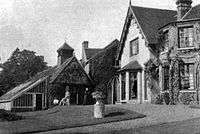Flitwick Manor
| Flitwick Manor | |
|---|---|
.jpg) | |
 Location in Bedfordshire | |
| General information | |
| Location | Flitwick, Bedfordshire, England |
| Coordinates | 51°59′47″N 0°30′9″W / 51.99639°N 0.50250°W |
Flitwick Manor is a Grade II* Listed[1] Georgian country house in the south of Flitwick, Bedfordshire, England. It is located on Church Road off the A5120 road. It is currently run as a hotel by the hotelier firm Menzies.[2]
Early history

Edward Blofield built Flitwick Manor in 1632.[3] He died in 1663 and left the property to his young wife Jane.[4] In 1668 she married Samuel Rhodes and the property passed through the Rhodes family until it was bequeathed in 1736 by Benjamin Rhodes to Humphry Dell who was a relative.[5] Humphry Dell (1706-1764) was a physician who practiced in Flitwick. He was a friend of Jeffrey Fisher and acted as godfather to his daughter Anne who was born in 1757. When Dell died in 1764 he left Flitwick Manor to Anne Fisher, his goddaughter, but as she was only seven years old. Her father Jeffrey Fisher was the proprietor until she turned twenty-one. An engraving of Flitwick Manor was made during this time in 1776 which is shown. Anne married James Hesse of Edmonton in 1778 but he died in 1783 and in 1789 she married George Brooks (1741-1817). The Manor then came into the possession of the Brooks family where it remained for the next 200 years.
The Brooks family

George Brooks was a barrister and banker in London. After he married Anne he continued to live there and rented Flitwick Manor. Robert Trevor was a very significant tenant as it was he who instigated the significant changes to the Manor between 1793 and 1808. He agreed with George Brooks to pay half of the costs.[6] In 1816 George's son John Thomas Brooks (1794-1858) was given Flitwick manor on his marriage to Mary Hatfield. This couple lived there for the rest of their lives.
John Thomas Brooks wrote several diaries which give a picture of life at Flitwick Manor. He was particularly fond of his garden and made major improvements to the grounds.[7] When he died in 1858 his eldest son Major John Hatfield Brooks inherited the Manor. John Hatfield Brooks had married Sophia Margaret Cloete in 1850 in Calcutta. The couple had two daughters and when John died in 1907 his daughter Catherine Mary Frances Brooks (1853-1934) inherited the house.[8]
Catherine did not marry and lived in the house until she died at the age of 81 in 1934. Her obituary outlined her work in the village of Flitwick and praised her generosity. When she died she had no heirs so she left the property to her cousin Robert Adolphus Lyall (1876-1948).[9] When he died in 1948 it was left to John Comyn Lyall. He advertised it for sale in 1953. It was bought by Anthony Gilkison who was a film director who lived there until the early 1970s.[10]
Later history
It stayed in private hands until 1984 when Somerset Moore converted it to a restaurant. This was sold in 1990. Today it retains many old antiques and old furnishings.
When the manor was undergoing renovation, Jim Sparkes, a builder, discovered a wooden door beneath the roof tiles, opening into a hidden secret room. Inside the room was a bricked-up doorway which had led into the upper floor of the manor. The room was believed to have been the quarters of an old white-haired housekeeper. Flitwick Manor is reported to be haunted and apparitions of this housekeeper have been reported. A hotel manager has reported being confronted by her in a corridor and the staff are reportedly very familiar with her presence and know her favourite chair, as she often leaves an impression on the cushion. It is also believed to be the wife of Mr. Brooks, whose daughter (Mary Ann) died of cancer early on in her life. This drove the couple apart, and Mrs. Brooks left Flitwick Manor because of it.[11]
References
- ↑ Historic England. "Flitwick Manor (Grade II*) (1137690)". National Heritage List for England. Retrieved 9 August 2014.
- ↑ www.menzies-hotels.co.uk
- ↑ English Heritage Register “Flitwick Manor”. Online reference
- ↑ Genealogia Bedfordiensis, A. D. 1538-1700, p. 394. Online reference
- ↑ Bedfordshire Archives. Online reference
- ↑ Case studies of some estate gardens in Bedfordshire”, p. 9. Online reference
- ↑ Thompson F. “English Landed Society in the Nineteenth Century” , p. 132. Online reference
- ↑ Bedfordshire Times and Independent - Friday 26 October 1934, p. 9.
- ↑ Bedfordshire Times and Independent Bedfordshire, England 25 Jan 1935
- ↑ British Phone Books
- ↑ Haunted Rooms: Flitwick Manor